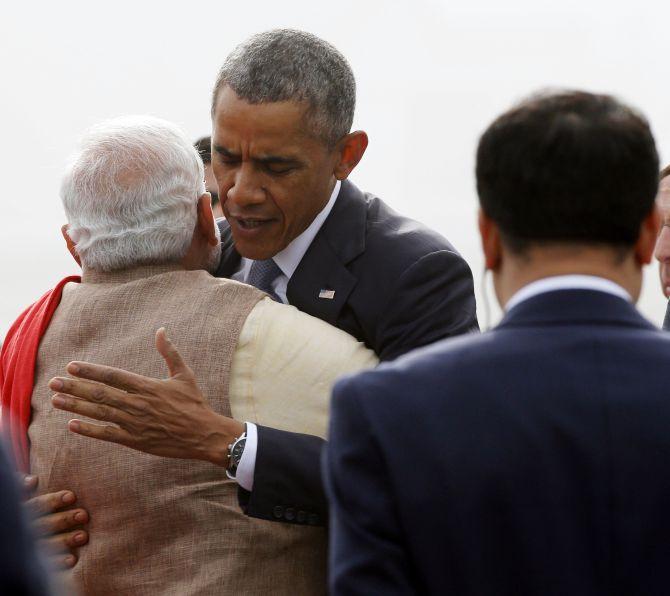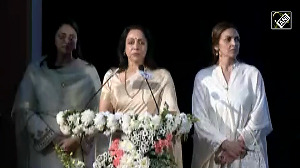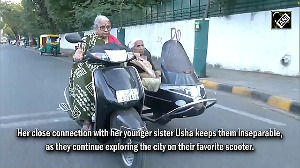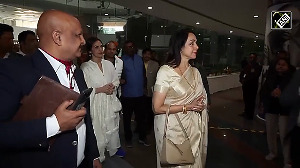 'It was statecraft that came out on top and clearly outweighed the optics,' says Brigadier Gurmeet Kanwal (retd). 'And this is the first time the US has formally recognised the threat India faces from terrorist organisations based in Pakistan.'
'It was statecraft that came out on top and clearly outweighed the optics,' says Brigadier Gurmeet Kanwal (retd). 'And this is the first time the US has formally recognised the threat India faces from terrorist organisations based in Pakistan.'
The optics during the Modi-Obama summit were impressive: The prime minister setting aside protocol to personally receive the US President at Palam airport, several warm hugs, 'chai pe charcha', shared smiles, jokes and laughter and the liberal use of first names.
All of these were indicative of a growing personal rapport, even friendship.
However, it was statecraft that came out on top and clearly outweighed the optics. The achievements of the Republic Day summit were truly outstanding and have propelled India-US strategic partnership to the next higher orbit.
The summit carried forward the work done during Prime Minister Narendra Modi's first meeting with President Obama at the White House in September 2014. The two sides reviewed the progress and agreed to enhance mutual trade and work towards the removal of barriers to investment.
They also approved greater cooperation in the fields of higher education, science and technology, information and communication technology, space, renewable energy, health, climate change, food security, development of capital markets and smart cities and people to people contacts, among a host of other areas of mutual interest.
It is in the field of security and defence cooperation that the summit accomplished the most significant forward movement. The 15-year-old strategic partnership has been upgraded to the status of a global partnership, giving India a larger role in international affairs.
The Defence Framework Agreement signed in June 2005 has been renewed for another 10 years. The remaining hurdles in the operationalisation of the civil nuclear energy cooperation agreement have been overcome.
The US has stated its intention to work with India to ensure that it is free to acquire civil nuclear technology and nuclear fuel and to support India's membership of the Nuclear Suppliers Group, the Missile Technology Control Regime, the Wassenaar arrangement and the Australia Group.
The 'India-US Delhi Declaration of Friendship,' one of the three joint statements issued after the meeting, is a step 'towards shaping international security, regional and global peace, prosperity and stability.'
As part of this declaration, the two countries agreed to hold regular summits with increased periodicity; elevate the strategic dialogue to a strategic and commercial dialogue; establish secure hotlines between the two heads of government and their national security advisors; cooperate to develop joint ventures on strategically significant projects; build meaningful security and effective counter-terrorism cooperation; hold regional and multilateral consultations; and, leverage the talents and strengths of the people of India and the US to enhance sustainable, inclusive development around the globe.
Another significant agreement that will have a lasting impact on peace and stability and the balance of power in the Indo-Pacific region is the 'India-US Joint Strategic Vision for the Asia-Pacific and Indian Ocean Region.'
This agreement will promote regional economic integration. It will help to safeguard maritime security and the freedom of navigation and over-flights throughout the region.
As a telling rejoinder to recent Chinese military assertiveness, the vision statement notes that the two countries will work together to ensure security 'especially in the South China Sea.'
The two countries will seek multilateral opportunities to build capacities for long-term peace and prosperity in the region. The US agreed to strengthen the East Asia Summit and welcomed India's interest in joining the Asia Pacific Economic Cooperation, APEC, forum as a growing economy.
Of the 17 defence technology projects that had been initially offered under the rubric of the Defence Trade and Technology Initiative, DTTI. launched in September 2013, four projects were shortlisted for joint development and co-production.
These 'pathfinder' projects include the next generation Raven hand-launched, 10-km range mini UAV for battlefield surveillance, the development of a roll on-roll off (RoRo) intelligence, surveillance and reconnaissance (ISR) package for the C-130J aircraft acquired by India from the US for its Special Forces, mobile electric hybrid power engine and an integrated kit for the protection of soldiers while operating in a chemical and biological warfare environment.
While none of the four projects offers futuristic technology, the original intention of the DTTI was to work together on technologies that are 'unique and viable to produce.'
Two of the four projects will be undertaken as joint ventures with the US government and the other two as JVs with American MNCs. It was also agreed that working groups will be established to study the joint development of jet engine technology and future aircraft carrier technologies, for example, aircraft launch systems.
India has a low defence technology base and would welcome collaboration in the development of future weapons platforms and other defence equipment like radars, target seekers and navigation systems.
The first four projects are a good beginning as these joint ventures will provide invaluable experience for the establishment of public-private partnerships for the co-development of defence equipment.
The two sides agreed to enhance cooperation in maritime security, including enlarging the scope of the Malabar series of annual naval exercises by making them multilateral through invitations to other Asian powers like Australia and Japan to participate.
They expressed their resolve to further step up operational coordination for counter-terrorism operations. A notable development was the reaffirmation of the 'need for joint and concerted efforts to disrupt entities such as Lashkar-e-Tayiba, Jaish-e-Mohammad, D Company and the Haqqani Network.'
This is the first time that the US has formally recognised the threat that India faces from the terrorist organisations that are based in Pakistan.
Overall, it was an eminently successful summit that was not limited merely to feel-good declarations, but also resulted in a number of practical, mutually beneficial takeaways.
Perhaps the most important of these was the expression of the two countries' determination to work together for peace and stability in the Indo-Pacific. This challenging commitment may one day lead to a requirement for India to undertake joint operations to deal with a contingency.
By tacitly agreeing to discharge its responsibilities as a regional power, India has at long last stood up to be counted. If India intervenes militarily in its regional neighbourhood, joint operations will not be undertaken because it is in the American interest, but because it is in India's interest as a member of a cooperative security framework that seeks to maintain harmony in the use of the Global Commons in the Indo-Pacific.
With this giant foreign policy leap, India's relationship with the US is set to move forward on a steep upward trajectory.
Brigadier Gurmeet Kanwal (retd) is former Director, Centre for Land Warfare Studies, CLAWS, New Delhi.
Image: Prime Minister Narendra Modi welcomes President Obama at Palam Air Force Base in New Delhi. Photo: Press Information Bureau.










